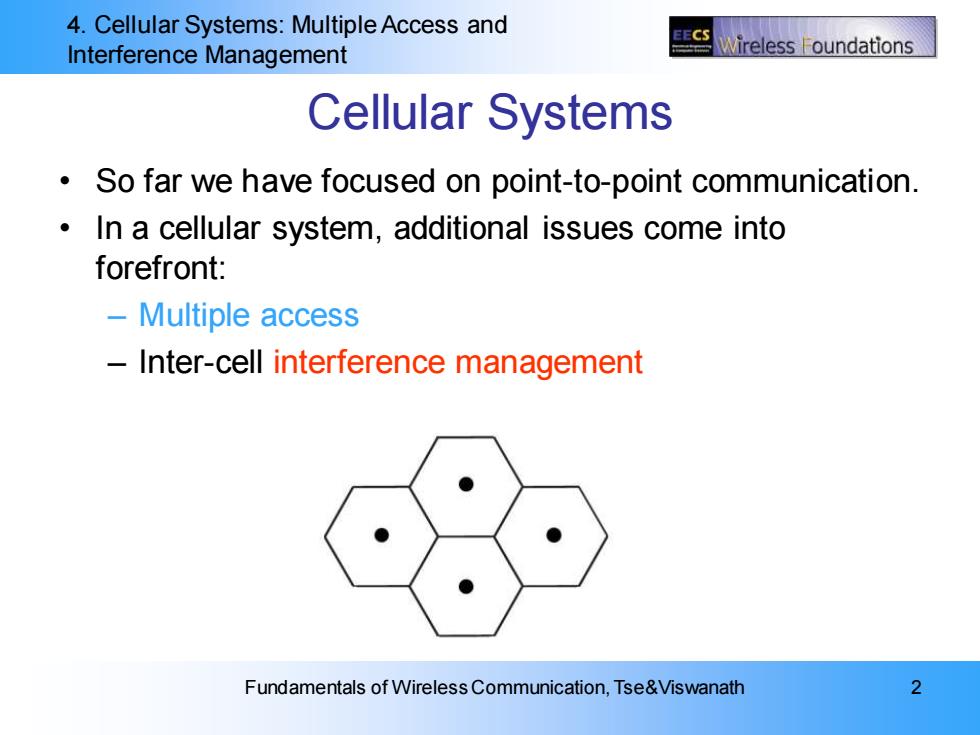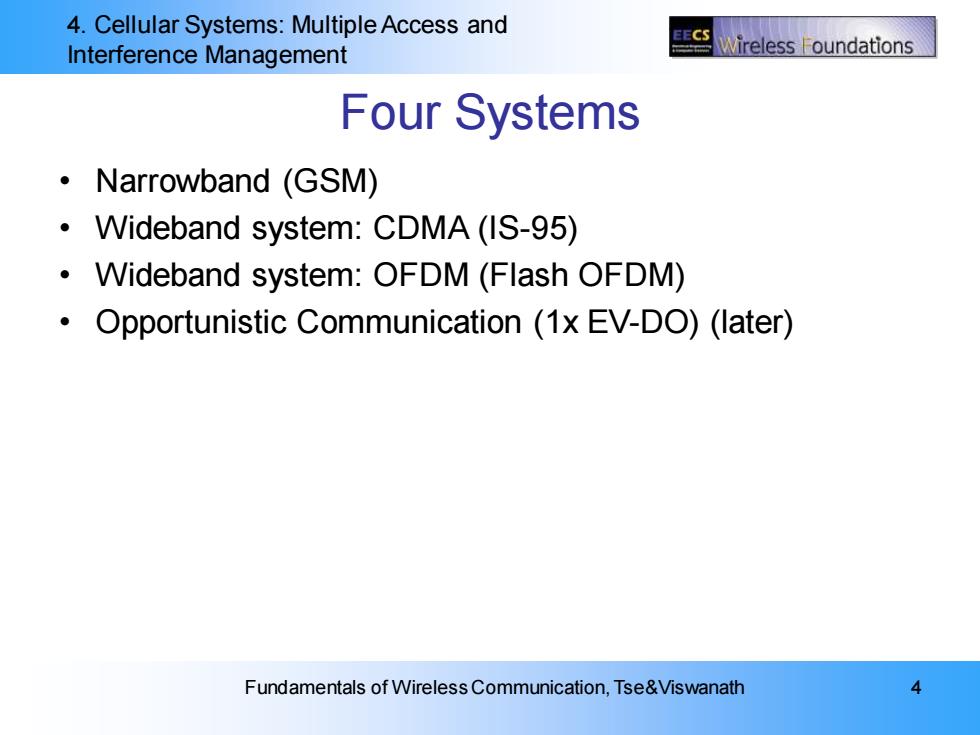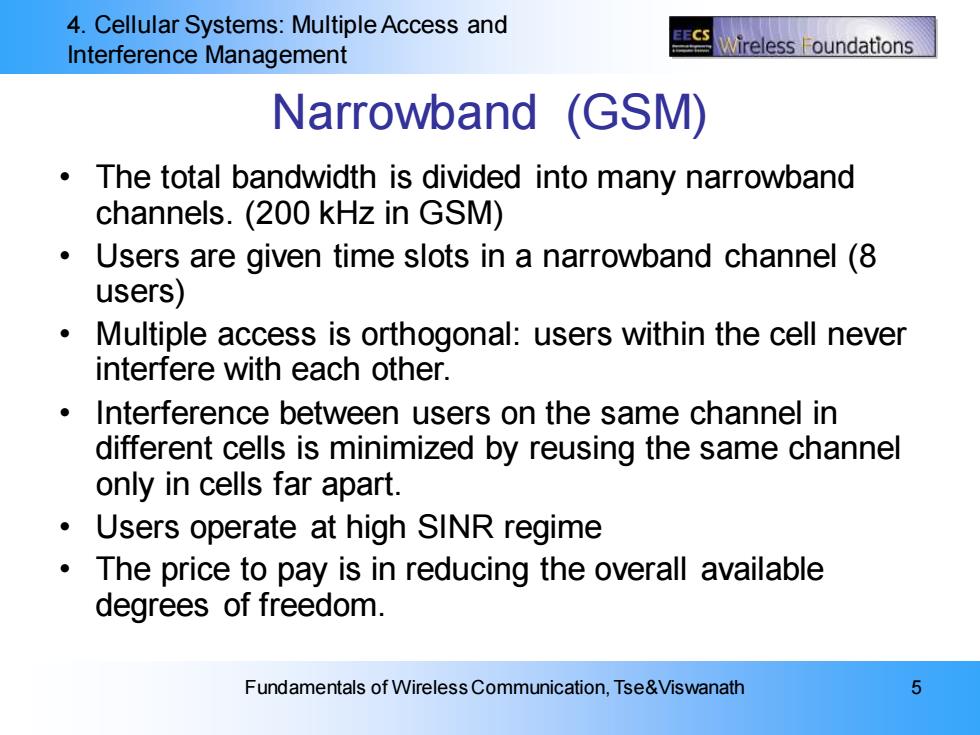
EECS Wireless Foundations 4.Cellular Systems: Multiple Access and Interference Management Fundamentals of Wireless Communication,Tse&Viswanath
4. Cellular Systems: Multiple Access and Interference Management Fundamentals of Wireless Communication, Tse&Viswanath 1 4. Cellular Systems: Multiple Access and Interference Management

4.Cellular Systems:Multiple Access and EECS Interference Management Vireless oundations Cellular Systems So far we have focused on point-to-point communication. In a cellular system,additional issues come into forefront: Multiple access Inter-cell interference management Fundamentals of Wireless Communication,Tse&Viswanath 2
4. Cellular Systems: Multiple Access and Interference Management Fundamentals of Wireless Communication, Tse&Viswanath 2 Cellular Systems • So far we have focused on point-to-point communication. • In a cellular system, additional issues come into forefront: – Multiple access – Inter-cell interference management

4.Cellular Systems:Multiple Access and EECS Interference Management Wireless F oundations Some History Cellular concept (Bell Labs,early 70's) AMPS (analog,early 80's) GSM(digital,narrowband,late 80's) IS-95(digital,wideband,early 90's) ·3G/4 G systems Fundamentals of Wireless Communication,Tse&Viswanath 3
4. Cellular Systems: Multiple Access and Interference Management Fundamentals of Wireless Communication, Tse&Viswanath 3 Some History • Cellular concept (Bell Labs, early 70’s) • AMPS (analog, early 80’s) • GSM (digital, narrowband, late 80’s) • IS-95 (digital, wideband, early 90’s) • 3G/4G systems

4.Cellular Systems:Multiple Access and Interference Management Wireless oundations Four Systems ·Narrowband(GSM) Wideband system:CDMA(IS-95) Wideband system:OFDM(Flash OFDM) Opportunistic Communication (1x EV-DO)(later) Fundamentals of Wireless Communication,Tse&Viswanath 4
4. Cellular Systems: Multiple Access and Interference Management Fundamentals of Wireless Communication, Tse&Viswanath 4 Four Systems • Narrowband (GSM) • Wideband system: CDMA (IS-95) • Wideband system: OFDM (Flash OFDM) • Opportunistic Communication (1x EV-DO) (later)

4.Cellular Systems:Multiple Access and Interference Management Wireless F oundations Narrowband (GSM) The total bandwidth is divided into many narrowband channels.(200 kHz in GSM) Users are given time slots in a narrowband channel(8 users) Multiple access is orthogonal:users within the cell never interfere with each other. Interference between users on the same channel in different cells is minimized by reusing the same channel only in cells far apart. 。 Users operate at high SINR regime The price to pay is in reducing the overall available degrees of freedom. Fundamentals of Wireless Communication,Tse&Viswanath 5
4. Cellular Systems: Multiple Access and Interference Management Fundamentals of Wireless Communication, Tse&Viswanath 5 Narrowband (GSM) • The total bandwidth is divided into many narrowband channels. (200 kHz in GSM) • Users are given time slots in a narrowband channel (8 users) • Multiple access is orthogonal: users within the cell never interfere with each other. • Interference between users on the same channel in different cells is minimized by reusing the same channel only in cells far apart. • Users operate at high SINR regime • The price to pay is in reducing the overall available degrees of freedom